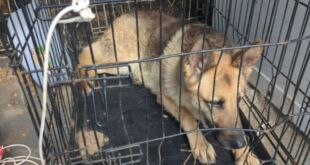Scientists tracing signatures of the novel coronavirus across different species have proposed that stray dogs — specifically dog intestines — may have contributed to the origin of the pandemic. According to the study, published in the journal Molecular Biology and Evolution, many animals, beginning with snakes and most recently, pangolins, have all been put forth as the likely intermediate hosts transmitting the virus, SARS-CoV-2, from bats to humans
However, according to Xuhua Xia from the University of Ottawa in Canada, the viruses isolated from these animals are too divergent from SARS-CoV-2.
“Our observations have allowed the formation of a new hypothesis for the origin and initial transmission of SARS-CoV-2,” Xia said.
“The ancestor of SARS-CoV-2 and its nearest relative, a bat coronavirus, infected the intestine of canids, most likely resulting in a rapid evolution of the virus in canids and its jump into humans,” Xia said. With scientists across the world scrambling to identify the species of origin to understand how the new coronavirus first leapt from its animal hosts to humans, the researcher believes the findings highlight the need for monitoring SARS-like coronaviruses in feral dogs.
According to Xia, the current study is based on the battle scars viruses get from fighting off and evading the host”s immune system using adaptations found within their genomes.
He said humans and mammals have a key antiviral protein, called ZAP, which can stop a virus in its tracks by preventing its multiplication in the host and degrading its genome.
Xia said ZAP targets a pair of chemical letters, called CpG dinucleotides, within its RNA genome.
However, the viruses can punch back, the study noted. Coronaviruses, like SARS-CoV, can avoid ZAP by reducing the CpG, thus rendering the antiviral protein powerless, the University of Ottawa scientist said.
According to the researcher, one implication of this is that the remaining CpG dinucleotides on the viral genome are likely functionally important for the virus. “Think of a decreased amount of CpG in a viral pathogen as an increased threat to public health, while an increased amount of CpG decreases the threat of such viral pathogens,” said Xia.
In the study, Xia examined all 1,252 full-length betacoronavirus genomes deposited into GenBank — an openaccess database of genetic sequences. He found that SARS-CoV-2, and its most closely related known relative, a bat coronavirus (BatCoV RaTG13), have the lowest amount of CpG among its close coronavirus relatives.
“The most striking pattern is an isolated but dramatic downward shift in viral genomic CpG in the lineage leading to BatCoV RaTG13 which was reported to be sampled from a bat (Rhinolophus affinis) in Yunnan Province in 2013, but only sequenced by Wuhan Institute of Virology after the outbreak of SARS-CoV-2 infection in late 2019,” Xia said.
“This bat CoV genome is the closest phylogenetic relative of SARS-CoV-2, sharing 96 per cent sequence similarity,” he added. The downshifting in CpG might have served as a warning due to two highly significant implications, the scientists said. “First, the virus likely evolved in a tissue with high ZAP expression which favours viral genomes with a low CpG,” Xia explained.
“Second and more importantly, survival of the virus indicates that it has successfully evaded ZAP-mediated antiviral defense. In other words, the virus has become stealthy and dangerous to humans,” he added.
When Xia examined the data in dogs, he found that only genomes from canine coronaviruses (CCoVs), which had caused a highly contagious intestinal disease worldwide in dogs, have CpG values similar to those observed in SARS-CoV-2 and BatCoV RaTG13.
The known cellular receptor for SARS-CoV-2 entry into the cell is ACE2 is also made in the human digestive system, at the highest levels in the small intestine and duodenum, with relatively low expression in the lung.
Based on this, the scientists suggested that the mammalian digestive system is likely to be a key target infected by coronaviruses. Humans are the only other host species Xia observed to produce coronavirus genomes with low genomic CpG values. Canids are often observed to lick their anal and genital regions, not only during mating but also in other circumstances. Such behaviour, the scientist said, would facilitate viral transmission from the digestive system to the respiratory system.
Based on his results, Xia presents a scenario in which the coronavirus first spread from bats to stray dogs eating bat meat.
Next, he said, the strong selection against CpG in the viral RNA genome in canid intestines may have resulted in rapid evolution of the virus leading to reduced genomic CpG. A reduced viral genomic CpG may have then allowed the virus to evade human ZAP-mediated immune response and became a severe human pathogen, Xia said.
“This study suggests that important evidence of viral evolution can be revealed by consideration of the interaction of host defenses with viral genomes, including selective pressure exerted by host tissues on viral genome composition,” Xia added.
Please Note: This article is not edited by DogExpress Team!

 DogExpress
DogExpress

















 in Chandigarh, India.
in Chandigarh, India. 
